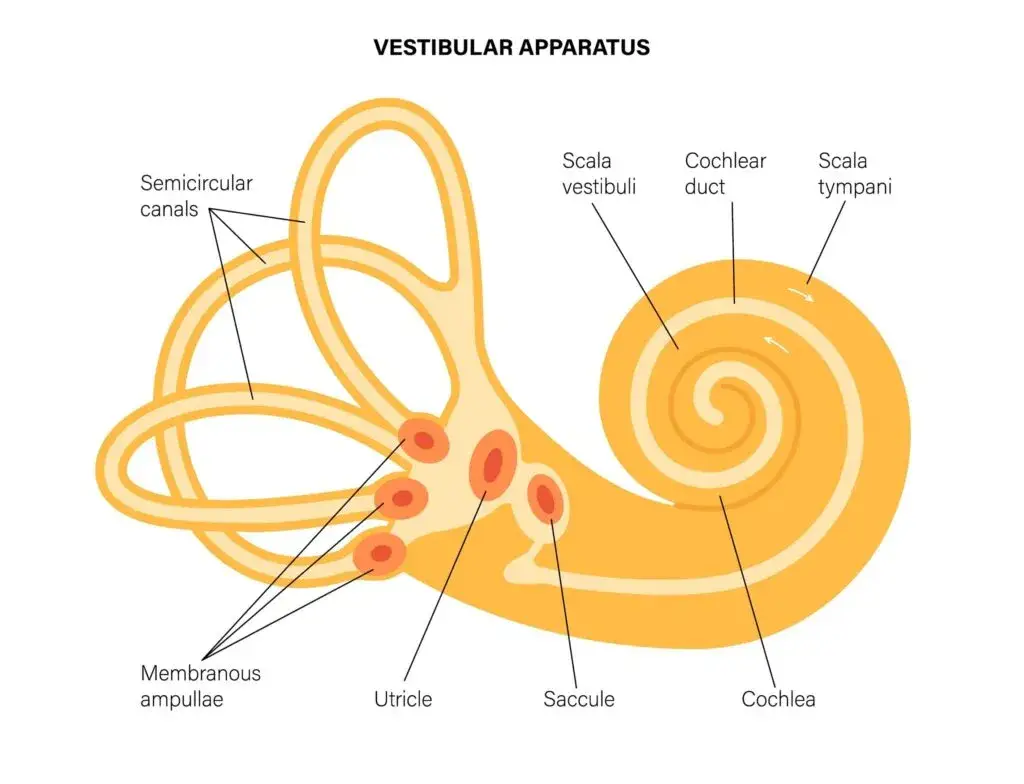
Barometric Pressure Headaches: Living on Florida’s Gulf Coast means sunshine—and sudden storms. If you’re in Sarasota, Bradenton, or Lakewood Ranch, you’ve probably felt a headache, ear pressure, or a dizzy “boat-on-the-bay” sensation roll in right before the rain. Those symptoms aren’t in your head; they’re often a response to fast-changing barometric pressure. For many people, especially those with a history of migraines, vertigo, ear fullness, or neck issues, storm fronts can flip a switch.
This in-depth guide explains how barometric pressure changes affect your head and inner ear, why upper cervical misalignment can make you more sensitive, how Eustachian tube dysfunction ties everything together, and how precise upper cervical chiropractic at Lavender Family Chiropractic in Sarasota can help you feel steady—rain or shine.
Barometric Pressure Headaches: What Is Barometric Pressure—and Why Do Storms Stir Up Headaches and Vertigo?
Barometric (atmospheric) pressure is the weight of the air around us. When a storm system approaches Sarasota, pressure tends to drop. That falling pressure subtly changes the pressure gradient between your sinuses, middle ear spaces, and the outside environment. If your body equalizes pressure efficiently, you may feel nothing. If it doesn’t, you can develop:
- Throbbing or pressure headaches (often around the forehead, temples, or behind the eyes)
- Ear fullness, popping, or crackling
- Dizziness or vertigo (spinning, rocking, or a swaying “dock” sensation)
- Neck tightness, jaw tension, light sensitivity, nausea
Why do some people feel these shifts more than others? Two big reasons:
- Pressure equalization bottlenecks—especially inside the Eustachian tubes, the small channels that connect the middle ear to the back of the nose/throat. If those tubes don’t open/close efficiently, pressure builds and you feel pain, fullness, or motion distortion.
- Sensitization of head and neck pathways—particularly in the upper cervical spine (the atlas and axis, C1 and C2) and in the trigeminal system (a key nerve network for facial and head sensation). When this system is already on “high alert,” even small pressure changes can tip you into symptoms.
How Barometric Pressure Triggers Headaches
Headache isn’t just “brain pain.” It’s a complex neurovascular response involving:
- Sinus and mastoid air cell pressure changing with the weather
- Trigeminal nerve activation (often the driver behind migraine)
- Autonomic nervous system shifts that affect blood vessel tone, pain pathways, and sensitivity to light/sound
- Musculoskeletal inputs from the upper neck and jaw that can amplify trigeminal sensitivity
When a low-pressure system arrives, the pressure outside your head drops. If your sinuses and middle ears can’t equalize efficiently, tissues swell and the trigeminal system can be triggered—especially if it’s already sensitized. You may experience pulsating pain, eye pressure, or a “band” around your head. Many patients tell us, “I can predict the storm before my weather app does.”
How Barometric Pressure Triggers Vertigo and Ear Symptoms
Your inner ear (the labyrinth) senses motion using fluid-filled canals. Pressure changes can alter fluid dynamics and the way tiny hair cells fire signals about movement and position. If the Eustachian tubes aren’t letting the middle ear equalize, you may feel:
- A muffled or “underwater” ear
- Popping or clicking when you swallow or yawn
- Brief spins when you look up/down or roll over
- Rocking/tilting when you’re still—especially right before a storm
Even without a diagnosed vestibular condition, barometric shifts can produce a mismatch between what your eyes see, your inner ear senses, and what your neck proprioceptors (position sensors) report. That mismatch = dizziness.
The Eustachian Tube Connection: Why Some People Feel Every Storm
Your Eustachian tubes are narrow canals that must open briefly every time you swallow or yawn to equalize pressure. When they don’t, you get Eustachian Tube Dysfunction (ETD)—ear pressure, fullness, muffled hearing, even dizziness. ETD can flare with allergies, colds, or sinus congestion, but it also shows up in people with:
- Upper cervical misalignment that changes head/neck posture and muscle tone
- Jaw tension/TMJ issues that affect the muscles near the tubes
- Poor nasal breathing or chronic mouth breathing
- Postural imbalances (forward head posture, shoulder/hip tilt)
Here’s the key: the muscles and nerves that help the Eustachian tubes open/close work in the same neighborhood as your upper neck and jaw structures. When the upper cervical region is misaligned—even slightly—it can change tension patterns in the suboccipitals, throat and palate muscles, and jaw muscles. Over time, that can make ETD more likely and storm-days more symptomatic.
Upper Cervical Misalignment: The Hidden Sensitizer
The top two vertebrae—C1 (Atlas) and C2 (Axis)—sit right under the skull and help protect the brainstem. They’re uniquely mobile to allow head rotation and nodding, but that mobility also makes them vulnerable to subtle misalignment from stress, microtrauma, previous accidents, sports, or even long hours at a desk.
Why that matters for barometric pressure symptoms:
- Neurological modulation: The brainstem area integrates autonomic (automatic) functions—think blood vessel tone, pain sensitivity, and balance reflexes. If the atlas/axis are out of their neutral alignment, the surrounding soft tissues and mechanoreceptors can send noisy signals into the system. The result? Lower thresholds for headache, ear pressure, and dizziness.
- Proprioceptive mismatch: Your upper neck is a hub for position-sensing nerves. Misalignment can create conflicting input between the neck and inner ear, setting the stage for vertigo—especially when a storm adds pressure changes to the mix.
- Muscle tone and drainage: Misalignment often increases tension in suboccipital muscles and affects lymphatic/venous drainage patterns around the head/neck. That congestion can amplify sinus/ear pressure when the weather swings.
- Jaw and palate interplay: The upper neck and jaw are functionally linked. Atlas/axis imbalance can coincide with clenching, TMJ irritation, and altered mechanics around the soft palate where Eustachian tube muscles operate. That can make equalization sluggish on stormy days.
In short, barometric pressure isn’t the whole story. It’s often the trigger, while upper cervical misalignment is the amplifier.
Why Sarasota’s Storm Rhythm Makes Symptoms More Noticeable
Gulf Coast weather can change quickly—sudden afternoon thunderstorms, tropical systems, and pressure swings ahead of cold fronts. If you’re sensitive, you may notice a pattern:
- Several hours before a storm: a mild, pressing headache, ear fullness, or a “wobbly deck” sensation
- During the storm: intensifying pressure, sound/light sensitivity, neck tightness
- Afterward: lingering fogginess or fatigue
If this sounds familiar, your system is likely struggling to equalize pressure and modulate sensory input. That’s exactly where upper cervical care can help.
Upper Cervical Chiropractic 101: Gentle, Precise, No Popping or Twisting
Upper cervical chiropractic focuses exclusively on the alignment and stability of C1 and C2. Unlike general spinal manipulation, our approach at Lavender Family Chiropractic is gentle and precise—no popping, twisting, or cracking. We use advanced imaging and neuro-scans to pinpoint the exact direction and degree of misalignment and then apply a specific correction designed just for you.
What makes our approach different:
- 3D CBCT Imaging: We use state-of-the-art 3D Cone Beam CT to visualize the unique angles of your upper neck. That 3D clarity helps us craft a correction with millimeter-level specificity.
- Functional Nervous System Scans (Tytron Paraspinal Infrared Thermography): These noninvasive scans measure thermal asymmetries along your spine that correlate with autonomic nervous system stress. It’s an objective way to assess when your body is “stuck” and when it’s adapting better post-adjustment.
- Knee-Chest Upper Cervical Technique: A time-tested, comfortable method that allows a targeted, low-force correction to the atlas/axis.
- Rest & Recheck: After your first correction, we typically allow your body time to “set,” re-scan, and verify progress.
- Stability First Philosophy: The goal isn’t endless adjustments; it’s to help your upper cervical spine hold alignment so your nervous system can calm down—and your storm-day triggers quiet down, too.
How Correcting the Upper Cervical Spine Helps Barometric Pressure Symptoms
When your atlas/axis alignment improves, you may notice:
- Fewer barometric headaches: With brainstem irritation reduced and trigeminal pathways less reactive, pressure swings tend to produce less pain.
- Easier ear equalization: Improved posture and muscle tone can take strain off the areas surrounding the Eustachian tubes, helping them open more efficiently.
- Steadier balance: Neck–inner ear mismatch settles as proprioceptive input becomes more accurate. Many patients report feeling “more grounded” during weather changes.
- Better drainage: As soft tissue tension normalizes, sinus and venous drainage can improve, reducing that heavy, congested head feeling when storms roll in.
Lavender Family Chiropractic: Sarasota’s Upper Cervical Team for Headaches, Vertigo, ETD, and “Weather Sensitivity”
At Lavender Family Chiropractic in Sarasota (5899 Whitfield Ave Ste 107, Sarasota, FL 34243), our three-doctor team—Dr. Rusty Lavender, Dr. Jacob Temple, and Dr. Will Guzinski—specializes in upper cervical care for complex cases: migraines, vestibular issues (BPPV, MdDS, vestibular migraine, Meniere’s), ear pressure, TMJ, neck pain, POTS, trigeminal/occipital neuralgia, and post-concussion symptoms. Patients consistently share how barometric pressure days no longer “rule their calendar” after care begins.
What to expect when you start care:
- Step 1: Complimentary Consultation
We listen. We map your timeline, triggers (including storms), and goals. - Step 2: Neurologic Exam & Tytron Scan
We assess posture, balance, cervical range of motion, and running thermal scans to identify nervous system stress. - Step 3: 3D CBCT Imaging
If your case calls for it, we take CBCT scans to visualize your exact atlas/axis alignment and customize your plan. - Step 4: Gentle, Precise Correction
Using knee-chest technique, we perform a tailored correction—no twisting or cracking. - Step 5: Post-Adjustment Rest & Recheck
We allow your body to settle, then re-scan to verify changes. - Step 6: Stabilization Care
We coach you on lifestyle steps that help your alignment hold—sleep setup, desk ergonomics, hydration, and storm-day strategies.
We proudly serve Sarasota, Bradenton, Lakewood Ranch, Parrish, Ellenton, Venice, Osprey, Punta Gorda, St. Petersburg, Siesta Key, Longboat Key, Lido Key, and Myakka City, and we’re recognized as the best upper cervical chiropractic office in Sarasota, Lakewood Ranch, and Bradenton by our community. Many patients find us searching “chiropractor Sarasota Florida,” “upper cervical chiropractor near me,” “Vertigo doctor near me,” or “Migraine doctor near me”—and leave five-star reviews after finally getting answers.
Smart Storm-Day Strategies (That Pair Perfectly with Upper Cervical Care)
While we focus on correcting the root cause, simple habits can make storm swings easier:
- Track pressure trends: Use a weather app to get alerts when pressure is forecast to fall. Start hydration early and avoid skipped meals.
- Breathe better: Gentle nasal breathing drills and humidified air can ease sinus pressure. Saline rinses (when appropriate) help, too.
- Ear equalization hygiene: Swallow, sip water, or try a gentle Valsalva if your provider approves. Avoid forceful clearing that worsens ETD.
- Neck-friendly posture: Keep screens at eye level; use a soft neck rest during long drives or flights.
- Magnesium-rich routine: Talk with your provider about magnesium glycinate or citrate, especially if you have migraine tendencies.
- Light/sound control: Sunglasses, a hat brim, or noise-dampening headphones help when storms make you sensory-sensitive.
- Steady sleep & gentle movement: Consistent bed/wake times and light walks support autonomic balance.
Remember: If you experience sudden severe headache, new neurological deficits, facial droop, chest pain, or a true spinning vertigo with vomiting and inability to stand, seek urgent medical care.
Real-World Pattern We See in Sarasota Patients
- Before care: Every thunderstorm day = headache, ear fullness, and a “rocking” dizziness that ruins productivity. OTC meds give limited help and cause rebound issues.
- After precise upper cervical correction and stabilization: Fewer episodes, lower intensity, and much faster recovery. Many patients tell us, “I still notice the pressure drop, but it doesn’t take me out anymore.”
Your experience is unique, but the pattern of improved resilience is common when the neck–ear–autonomic system is allowed to function the way it’s designed.
Who’s a Great Candidate for Upper Cervical Care?
- You notice headaches/vertigo right before storms
- You feel ear fullness or popping, especially with altitude or weather changes
- You have a history of neck pain, whiplash, concussion, or TMJ
- You’ve tried medications or sinus treatments with partial relief
- You want a gentle, precise, no-popping approach that focuses on stability—not endless cracking
Top 15 FAQs About Barometric Pressure Headaches, Vertigo, and Upper Cervical Care
1) What exactly is a barometric pressure headache?
A headache triggered by rapid changes in atmospheric pressure. The pressure shift can sensitize sinuses, mastoid air cells, and trigeminal pain pathways—especially if your neck and autonomic system are already irritated. Upper cervical care helps reduce that baseline irritation so weather swings bother you less.
2) Why do I get ear popping and fullness when storms roll in?
Your Eustachian tubes may be slow to equalize pressure. Inflammation, allergies, jaw tension, and upper cervical misalignment can all contribute. When the atlas/axis are corrected and soft tissue tone normalizes, many people notice easier equalization and fewer “plugged ear” days.
3) Can barometric pressure cause vertigo?
It can contribute. Pressure shifts change how your middle ear equalizes and can influence inner ear fluid dynamics. If your neck–vestibular integration is already off, the mismatch can present as spinning, rocking, or tilting sensations.
4) How is upper cervical chiropractic different from general chiropractic?
We focus exclusively on the top of the neck (C1/C2), use 3D CBCT for precise imaging, and correct with gentle, targeted adjustments—no popping, twisting, or cracking. The aim is neurologic stability and alignment that holds, not frequent, forceful manipulation.
5) Will an upper cervical adjustment hurt?
No. Our knee-chest technique is low-force and highly specific. Most patients describe it as surprisingly gentle. Many notice immediate lightness or improved head/neck range of motion afterward.
6) How do you know if my upper cervical spine is misaligned?
We combine a detailed exam, Tytron paraspinal infrared thermography, postural analysis, and 3D CBCT imaging (when appropriate). These tools reveal the exact direction and degree of misalignment, plus objective nervous system stress patterns.
7) Can upper cervical care fix my Eustachian tubes?
We don’t “treat the tubes” directly. We correct the mechanical and neurologic contributors—posture, muscle tone, and autonomic balance—so your body can equalize pressure more efficiently. Many patients with ETD-like symptoms report fewer storm-day flares after care.
8) How long until I notice a difference on stormy days?
Every case is unique. Some feel changes within the first few corrections; others notice steady improvement over weeks as alignment stabilizes and the nervous system calms. Our focus is durable change, not quick but temporary fixes.
9) Do I still need my ENT or primary care doctor?
Absolutely. We collaborate. If we suspect sinus infection, sudden hearing loss, or other medical red flags, we’ll refer you. Upper cervical care complements medical care by addressing structural/neurologic contributors.
10) Could my jaw (TMJ) be worsening storm symptoms?
Yes. Jaw tension is common when the upper neck is misaligned. TMJ stress near the soft palate can influence the muscles that help the Eustachian tubes open. Correcting atlas/axis can reduce jaw guarding and improve overall balance.
11) What if my vertigo is BPPV—do I need canalith repositioning?
BPPV (loose ear crystals) often responds to repositioning maneuvers. If appropriate, we’ll guide you to evidence-based vestibular strategies and pair that with upper cervical correction to reduce recurrences tied to posture and neck proprioception.
12) I’m sensitive to meds—will your approach work for me?
Our care is non-pharmacological and gentle. Many people who prefer a natural route appreciate that we focus on alignment, neurologic function, and lifestyle strategies rather than medication reliance.
13) Do you take insurance?
Our office is out of network with insurance. Many patients receive a superbill to submit to their insurance for reimbursement based on their coverage. We offer a variety of payment and financing options to make care accessible.
14) How do I prevent barometric headaches at home?
Hydrate early, maintain a consistent sleep schedule, support nasal breathing, and watch your posture. Magnesium, gentle neck mobility, and light movement can help, too. The most impactful step we’ve seen is improving upper cervical alignment so your system is less reactive overall.
15) How do I start care at Lavender Family Chiropractic?
Call (941) 243-3729 or visit www.chiropractorsarasotaflorida.com to schedule a complimentary consultation. We’ll review your history, map your storm triggers, and—if you’re a candidate—create a precision plan to help you feel steadier in any weather.
Why Choose Lavender Family Chiropractic in Sarasota
- Gentle, precise corrections—no popping or twisting
- 3D CBCT imaging for true anatomical clarity
- Tytron infrared thermography to objectively track your progress
- Three-doctor team (Dr. Rusty Lavender, Dr. Jacob Temple, Dr. Will Guzinski) collaborating on complex cases
- A warm, family-centered environment focused on your goals
- Trusted by your neighbors across Sarasota, Bradenton, Lakewood Ranch, Parrish, Ellenton, Venice, Osprey, Punta Gorda, St. Petersburg, Siesta Key, Longboat Key, Lido Key, and Myakka City
- Follow our tips and education on Instagram @lavenderfamilysrq and TikTok @drrustylavender
Your Next Step: Get Ahead of the Next Storm
If the forecast sets off a countdown in your head—“Here comes the pressure headache… here comes the ear fullness… here comes the spin”—there’s a better way. By correcting the root cause in your upper cervical spine and calming the neurologic “noise” that amplifies weather changes, you can move from reactive to resilient.
Lavender Family Chiropractic in Sarasota Florida offers complimentary consultations to learn more about you. Click the link below!
https://intake.chirohd.com/new-patient-scheduling/724/lavender-family-chiropractic
Visit our Website!
To learn more about us go to http://www.chiropractorsarasotaflorida.com
We also service Bradenton, Parrish, Ellenton, Ruskin, Venice, Tampa, St. Pete, Osprey, Longboat, Lakewood Ranch, Myakka City.
If you are not local, visit www.uccnearme.com to find a doctor in your area.
Call





